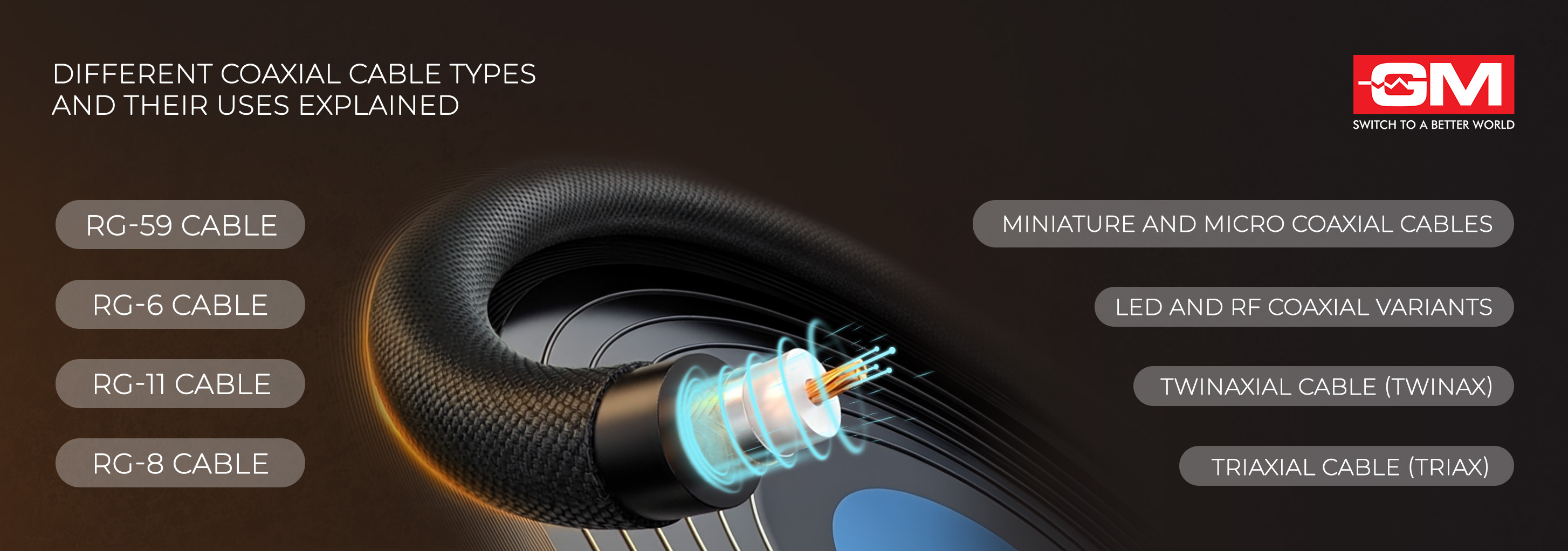Blog
Different Coaxial Cable Types and Their Uses Explained
Updated on Nov 2025

Coaxial cables play a silent yet crucial role in ensuring seamless data transmission across homes, offices, and industries in times when high-speed communication is at the core of connectivity. From the television delivering crisp HD signals to your Wi-Fi router maintaining stable internet connectivity, or surveillance systems streaming real-time footage, coaxial cables are the backbone of reliable signal transfer.
But not all coaxial cables are the same. Over the years, several different types of coaxial cables have been developed to meet varied needs, each offering unique performance characteristics in terms of signal loss, shielding, and flexibility. Choosing the right type can make a significant difference in transmission quality, durability, and even safety.
Helping you understand different coaxial cable types used today and how they work, here is a list of detailed breakdown. However, to begin with, let’s understand the basics.
What Is a Coaxial Cable?
A coaxial cable, or simply “coax,” is a type of electrical cable designed to transmit radio frequency (RF) signals with minimal interference and signal loss. It gets its name from its layered construction, where multiple components share a common axis hence the word “co-axial”.
A standard coaxial cable has four main parts:
-
Inner Conductor: This is the central wire (usually copper) that carries the signal.
-
Dielectric Insulator: Surrounds the inner conductor and keeps it separated from the next layer.
-
Metal Shield: Usually made of braided copper or aluminum, this layer blocks electromagnetic interference (EMI).
-
Outer Jacket: The protective plastic layer that safeguards the internal components from physical damage and moisture.
This layered design allows coaxial cables to transmit high-frequency signals over long distances without losing much quality, which is why they’re widely used for television, internet, and radio communication.
Why Are There Different Types of Coaxial Cables?
Just like how not all shoes fit every foot, not all coaxial cables fit every use. The different coaxial cable types exist because signal strength, frequency, and environmental conditions vary.
For instance, the cable that connects your CCTV camera isn’t the same as the one that delivers satellite TV signals. Some cables are designed for long distances, some for minimal interference, and others for flexibility or indoor/outdoor use.
Here is a list of the most common coaxial cable types you’ll come across, and where and why they’re used.
1. RG-59 Cable
The RG-59 cable is one of the oldest and most commonly used types of coaxial cables. It’s relatively thin and flexible, making it ideal for short-distance signal transmission.
Features of RG-59 Cable
-
Thinner core conductor
-
Higher signal loss over long distances
-
Flexible and easy to install
Uses of RG-59 Cable
-
Traditional analogue CCTV camera systems
-
Older television connections
-
Basic video transmission setups
If you’re setting up something small-scale, like a home security camera within 50 meters, RG-59 works perfectly fine. However, for longer cable runs or HD signal transmission, you might want to look at heavier variants like RG-6.
2. RG-6 Cable
The RG-6 coaxial cable is the most widely used modern version, especially for television, cable internet, and satellite systems. Compared to RG-59, it has a thicker conductor and better shielding, which allows it to carry high-frequency signals with minimal loss.
Features of RG-6 Cable
-
Thicker insulation and conductor
-
Lower signal loss over distance
-
Excellent noise and interference protection
Uses of RG-6 Cable
-
DTH and satellite TV connections
-
Cable broadband internet
-
Home theater systems
-
Digital TV antennas
3. RG-11 Cable
The RG-11 cable is the heavyweight in the coax family. It’s designed for long-distance signal transmission where lower cables would cause too much signal drop.
Because of its larger core and thicker insulation, it can handle frequencies over long runs without significant degradation, but it’s less flexible and harder to install.
Features of RG-11 Cable
-
Lowest signal loss among RG cables
-
Stiff, thick structure
-
Ideal for outdoor or underground installation
Uses of RG-11 Cable
-
Main cable lines in large buildings or complexes
-
Backbone connections for cable TV networks
-
Long-distance broadband or data transmission
RG-11 is for when you need efficient performance, like connecting the main distribution line from your service provider to your home or office.
4. RG-8 Cable
The RG-8 cable is thicker than both RG-59 and RG-6 and is commonly used for radio frequency (RF) transmission. You’ll often find it used in amateur radio setups, CB radios, and high-frequency antenna systems.
Features of RG-8 Cable
-
Supports higher power transmission
-
Lower signal attenuation
-
Sturdy and durable
Uses of RG-8 Cable
-
RF cables for radio communication
-
Ham radios or two-way radios
-
Base station antennas
If you’re dealing with RF signals, RG-8 provides better performance and durability.
Also, to see how coaxial cables are applied in real-world setups, read our blog on Top 8 Uses of Coaxial Cables
5. Twinaxial Cable (Twinax)
A twinaxial cable, or Twinax, takes things a bit further. Instead of one, it has two inner conductors inside the same shield, allowing differential signal transmission. This design reduces noise and improves signal integrity, especially in high-speed data communication.
Features of Twinaxial Cable
-
Two inner conductors for differential signals
-
Excellent noise immunity
-
High-speed data support
Uses of Twinaxial Cable
-
Server-to-server data transmission
-
Computer networking
-
Data centers and high-speed communication setups
Twinax cables are typically seen in enterprise environments; they’re not common in homes but are vital for reliable, high-performance networking.
6. Triaxial Cable (Triax)
The triaxial cable, or Triax, adds an extra layer of shielding beyond what standard coaxial cables offer. Essentially, it’s a coax cable with a second shield and an extra insulating layer in between.
Features of Triaxial Cable
-
Dual shielding for superior noise rejection
-
Reduced ground loop interference
-
More durable and secure
Uses of Triaxial Cable
-
Professional video and broadcast equipment
-
CCTV systems in high-interference zones
-
Medical imaging and laboratory setups
When you’re dealing with sensitive or high-quality video signals, like in news studios or production houses, triaxial cables are often the gold standard.
7. Miniature and Micro Coaxial Cables
As devices shrink, so must the cables. Miniature and micro coaxial cables are ultra-thin versions designed for compact electronic devices. Despite their size, they still carry high-frequency signals efficiently.
Features of Miniature and Micro Coaxial Cables
-
Extremely thin and lightweight
-
Flexible and space-saving
-
Suitable for tight installations
Uses of Miniature and Micro Coaxial Cables
-
Smartphones, laptops, and tablets
-
Cameras and drones
-
Medical devices and robotics
These cables are the hidden heroes inside almost every portable electronic gadget today.
8. LED and RF Coaxial Variants
For some specialised applications, there are RF coaxial cables specifically optimised for radio frequency use, for instance, in radio transmitters, modems, or wireless antennas.
Similarly, LED lighting systems and automation panels sometimes use miniature coax lines to ensure low-loss signal delivery between control units and lights. These are usually customised versions of RG or Twinax types.
Choosing the Right Coaxial Cable
When deciding which coaxial cable to use, consider these key factors:
-
Signal Type and Frequency – Higher frequencies require better shielding and thicker conductors.
-
Distance of Transmission – Longer cable runs need low-loss types like RG-6 or RG-11.
-
Indoor or Outdoor Use – Outdoor cables need UV and moisture resistance.
-
Flexibility and Space – In compact devices or tight spaces, go for miniature coax cables.
-
Budget and Durability – While high-grade cables cost more, they ensure consistent performance over time.
A coaxial cable isn’t just a wire; it’s a carefully engineered transmission line built to deliver clarity, consistency, and speed. From RG-59 used in basic CCTV setups to RG-11 that powers long-distance connections, every type has its role. Then you’ve got Twinaxial and Triaxial cables for advanced communication, and miniature coax cables powering your handheld devices.
Understanding these coaxial cable types helps you pick the right one for your needs, whether it’s a high-definition TV connection, internet setup, or professional broadcasting line. The right cable ensures not just better performance but also long-term reliability.
To understand how different coaxial cables affect internet and signal performance, read our blog on How Coaxial Cables Improve Speed and Reliability
Frequently Asked Questions
Q. What is a coaxial cable used for?
A coaxial cable transmits high-frequency signals for applications like TV, internet, CCTV, and radio communication.
Q. What is the difference between RG-59, RG-6, and RG-11 cables?
RG-59 is for short distances, RG-6 for general home use (TV and broadband), and RG-11 for long-distance or outdoor installations.
Q. Are Triaxial cables better than Coaxial cables?
Yes, Triaxial cables offer better shielding and noise protection, making them ideal for professional broadcasting or sensitive equipment.
Q. Which coaxial cable should I use for my home TV setup?
For most homes, RG-6 is the best option. It delivers high-quality signals for both TV and broadband with minimal interference.
Related Blogs

Top GM Modular Fans to Add Comfort & Style This Festive Season
A festive season is more than lights and decorations; it's about creating a warm, welcoming space. As families gather, meals linger, and laughter fills rooms, comfort becomes just as important as looks. Amid all the décor decisions, one often-
Read More
Steam Iron vs Dry Iron: Which One Should You Buy?
Personality speaks for you when in pubic, and appearances, specifically, speak volumes. It is not a secret that well-ironed clothes have become a symbol of confidence and neatness. From a crisp shirt for an important meeting or a smooth saree for a f
Read More
3 Blade vs 4 Blade Fan: Which is Better for Your Home?
When it comes to choosing the perfect ceiling fan for your home, most people focus on design, colour, or brand, but the number of blades can make a surprisingly big difference in how your fan performs. You've probably noticed that some ceiling fans h
Read More
How to Calculate Cable Size: Complete Guide for Beginners
Every home, office, or industrial space runs on electricity, but behind the smooth glow of a light bulb or the seamless hum of a fan lies a silent hero, cables. Choosing the right cable isn't just about picking something that fits your budget. It's a
Read More